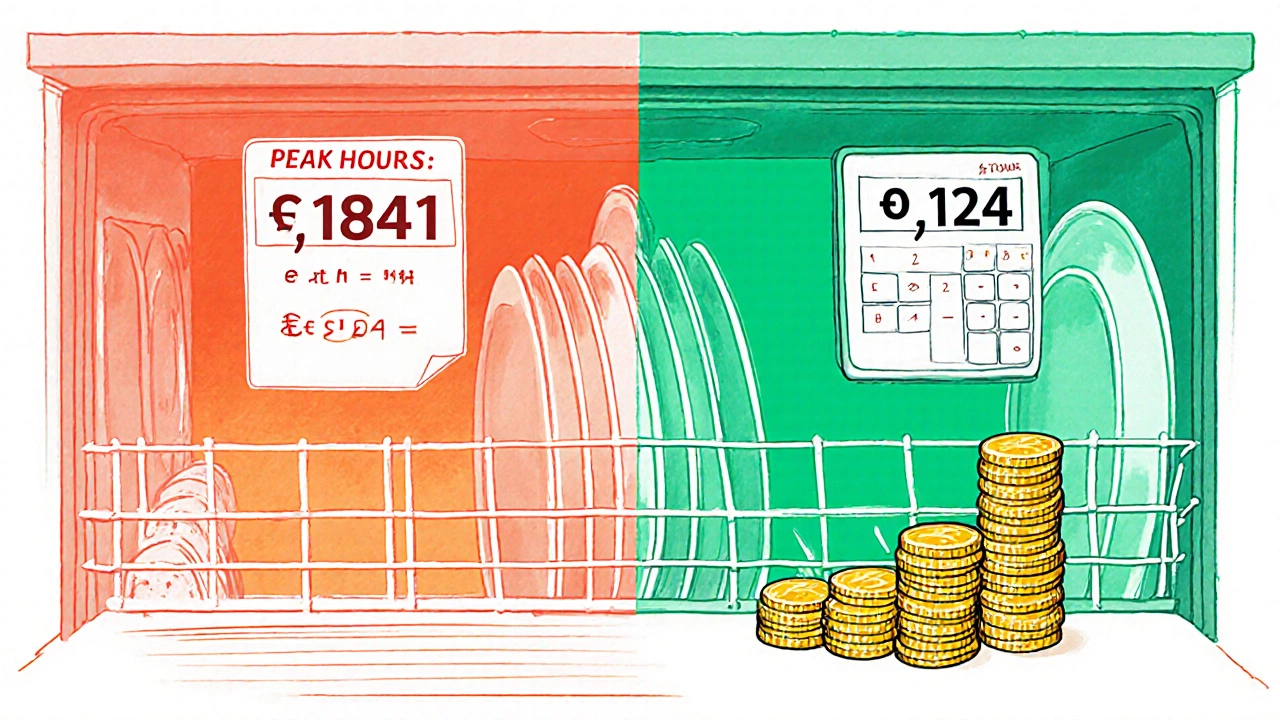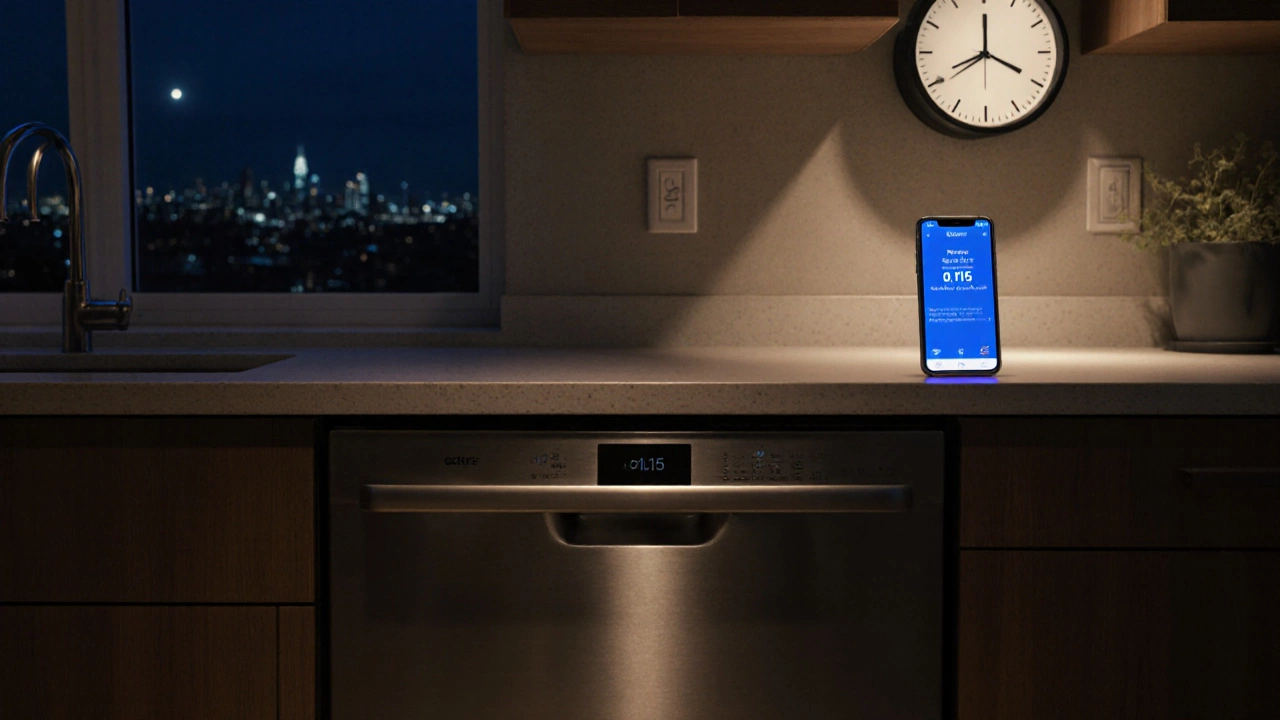Dishwasher Savings Calculator
Calculate Your Savings
Quick Takeaways
- Off‑peak rates can make a dishwasher cheaper to run, but the savings depend on your utility’s tariff structure.
- Calculate the exact difference by multiplying the dishwasher’s kWh use by the peak and off‑peak price per kWh.
- Modern dishwashers with Eco cycles and load sensors maximize savings regardless of the time of day.
- Noise, convenience, and local demand‑response programs may affect whether night‑time runs are practical for you.
- Use a smart‑meter‑enabled timer or the built‑in delay start to automate night‑time cycles.
Many homeowners wonder if tossing the dishes into the dishwasher after dinner and letting it run overnight really cuts the electricity bill. The answer isn’t a simple yes or no - it hinges on three things: the pricing plan your utility offers, how much energy your dishwasher consumes, and whether you can take advantage of built‑in efficiency features.
Dishwasher is a kitchen appliance that uses a combination of water, heat and mechanical motion to clean dishes automatically. Modern models typically draw between 0.9 and 1.5 kilowatt‑hours (kWh) per full load, depending on cycle length and temperature. If you pair that draw with a tariff that charges less for electricity after 9 p.m., you may see a modest reduction in the per‑load cost.
What’s a Time‑of‑Use (TOU) Rate?
Utilities in many regions, including BC Hydro in Vancouver, offer Time‑of‑Use rates that split the day into “peak” (high‑demand) and “off‑peak” (low‑demand) periods. During peak hours, the price per kilowatt‑hour can be 20‑30 % higher than the off‑peak price. The idea is to encourage consumers to shift flexible loads - like dishwashers, electric water heaters, or EV chargers - to times when the grid is under‑utilised.
In Vancouver, a typical residential TOU plan in 2025 looks like this:
- Peak (7 a.m. - 7 p.m.): $0.184 /kWh
- Off‑peak (7 p.m. - 7 a.m.): $0.124 /kWh
These numbers are illustrative; you should check your latest bill or the utility’s website for exact rates.
How to Calculate Potential Savings
Step‑by‑step, here’s how you can work out whether night‑time runs are cheaper for you:
- Find the dishwasher’s energy consumption per cycle. Check the EnergyGuide label or the user manual - look for a value in kWh. For this example, we’ll use 1.2 kWh for an Eco‑Wash load.
- Determine the price per kWh for peak and off‑peak periods (from your utility’s rate sheet).
- Calculate cost per load for each period:
- Peak cost = 1.2 kWh × $0.184 = $0.221
- Off‑peak cost = 1.2 kWh × $0.124 = $0.149
- Subtract the off‑peak cost from the peak cost. The difference ($0.072) is the saving per load.
- Multiply by the number of loads you run each month. If you run the dishwasher 20 times, you save roughly $1.44 per month - about $17 per year.
These figures show why the savings are often modest. The real benefit comes when you combine off‑peak timing with the dishwasher’s most efficient cycle.

Real‑World Cost Comparison
| Cycle | Energy Use (kWh) | Peak Cost ($/load) | Off‑peak Cost ($/load) | Monthly Savings (20 loads) |
|---|---|---|---|---|
| Normal (75 °C) | 1.5 | 0.276 | 0.186 | $1.80 |
| Eco‑Wash (55 °C) | 1.2 | 0.221 | 0.149 | $1.44 |
| Quick Rinse (no heat) | 0.9 | 0.166 | 0.112 | $1.08 |
The table makes it clear that the biggest savings come from using the Eco‑Wash cycle and running it during off‑peak hours. Even a high‑temperature load only saves a few cents per use.
Tips to Maximize Savings
- Use the Eco or Energy‑Star mode. These cycles lower water temperature and extend washing time, cutting energy use by up to 30 %.
- Load the dishwasher fully before starting. A half‑empty machine wastes the same amount of electricity as a full one.
- Take advantage of the built‑in delay‑start timer. Set it to begin at the start of the off‑peak window.
- If you have a smart meter, enable any demand‑response notifications. Some utilities send a signal to pause discretionary loads during grid stress, which can further lower your bill.
- Turn off the heated dry option and let dishes air‑dry. The dryer is often the most energy‑intensive part of the cycle.
- Regularly clean the filter and spray arms. Blockages force the machine to run longer, increasing electricity use.

Common Myths and Pitfalls
Myth 1: Night‑time runs always halve your electricity cost. In reality, the price difference between peak and off‑peak is usually less than 50 %, so the per‑load savings are modest.
Myth 2: Running the dishwasher at night saves water too. Water rates are typically flat, so timing doesn’t affect water cost.
Myth 3: All dishwashers benefit equally. Older, non‑Energy‑Star models consume more power and may not see noticeable savings even with cheap electricity.
Pitfall: Noise complaints. Running a dishwasher at 2 a.m. can disturb sleep, especially in apartments or houses with thin walls. If this is an issue, consider a quieter model or use the “low‑noise” setting if available.
Mini FAQ
Do I need a special electricity plan to save by running my dishwasher at night?
Yes. You must be on a Time‑of‑Use or similar tiered‑rate plan. Flat‑rate plans charge the same price all day, so night‑time runs won’t be cheaper.
How can I find out my exact off‑peak rate?
Check your latest utility bill or log into the online portal of your provider (e.g., BC Hydro). Look for a section titled ‘Time‑of‑Use rates’ or ‘Tiered rates’.
Will using the delay‑start feature waste extra energy?
No. The delay timer simply pauses the start of the cycle; the dishwasher still runs the same program once it begins.
Are there any rebates for buying an Energy‑Star dishwasher?
In British Columbia, the Clean Energy rebate often covers up to 30 % of the purchase price for qualifying Energy‑Star models. Check the provincial government’s energy‑efficiency website for current offers.
What if my utility’s off‑peak window is during the day?
Some plans define off‑peak as weekends or holidays. In that case, schedule washes for those periods instead of night‑time.
Next Steps & Troubleshooting
If you’ve confirmed you’re on a TOU plan, start by running one load on the Eco cycle during the next off‑peak window. Record the start‑time, cycle length, and any noise issues. Compare the bill after a month of night‑time runs with a month of daytime runs - the difference should line up with the calculations above.
Should you notice the dishwasher taking longer than usual, check the filter and spray arms for blockage. A clogged filter can increase cycle time by 20‑30 %, erasing any cost benefit.
Finally, if you discover that off‑peak rates are only marginally lower than peak, you may decide the convenience of running the machine after dinner outweighs the modest savings.

